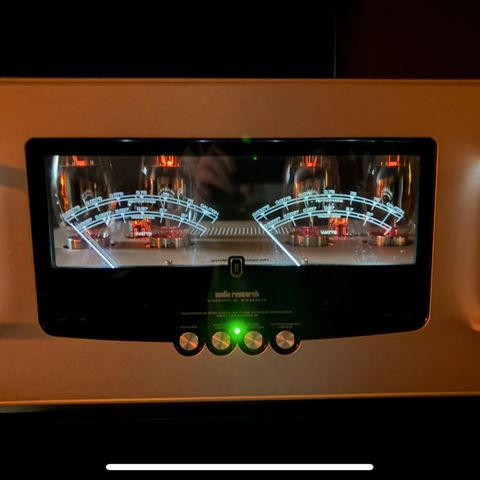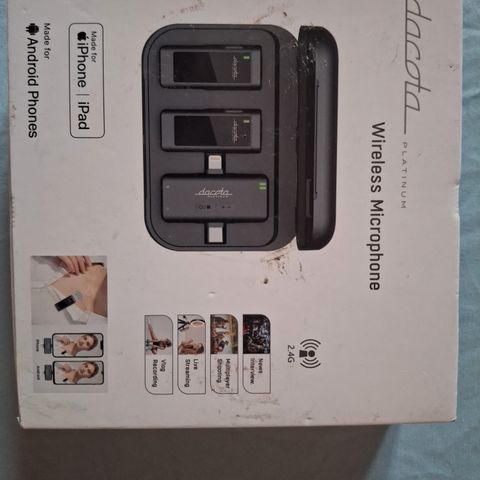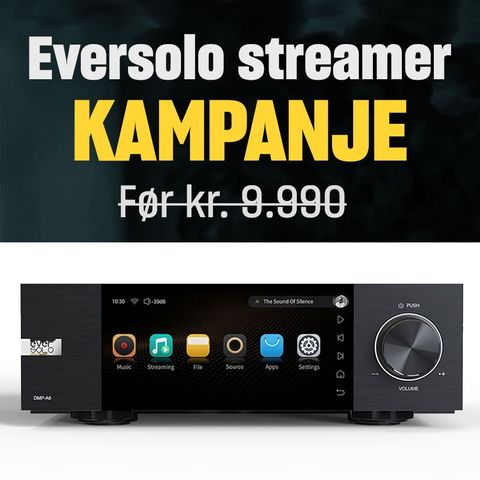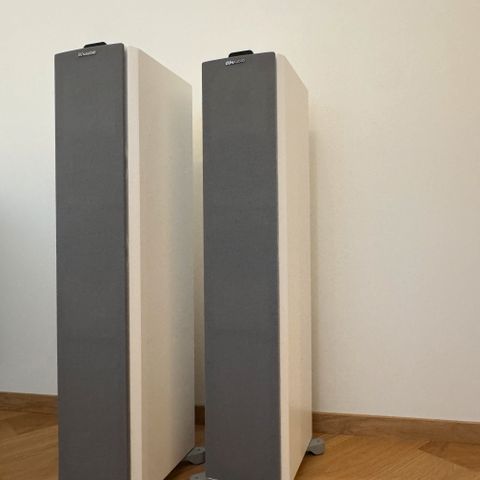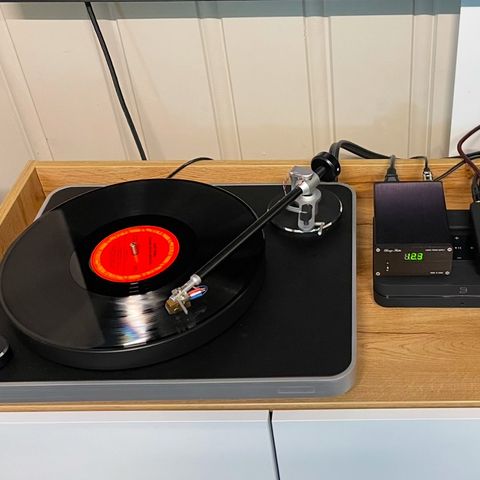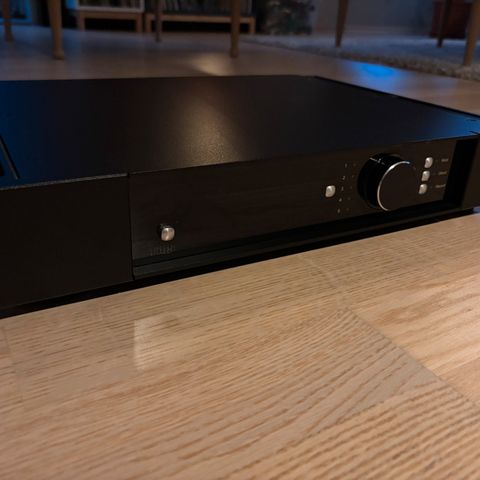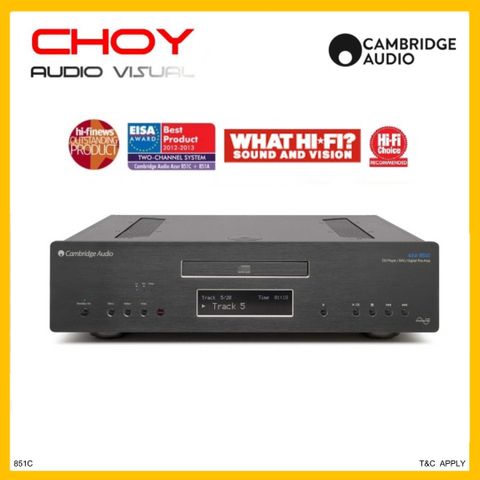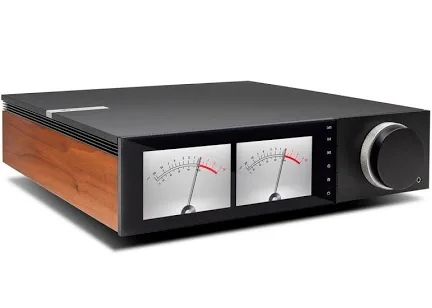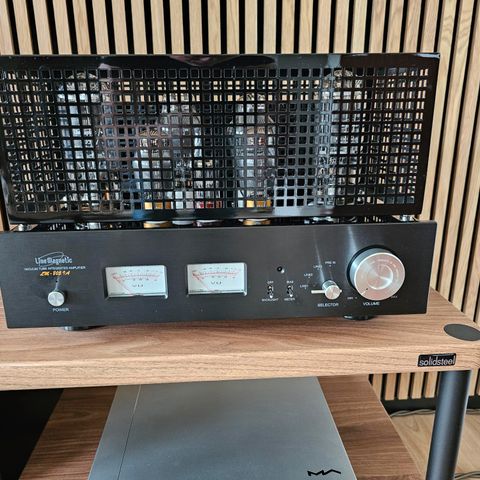Bildegalleri
Audolici A40i integrert rørforsterker
Beskrivelse av varen
Tilstand: Som ny - Ikke synlig brukt
Audolici er et meget spennende merke laget i Portugal av en hifi veteran fra tidligere soviet unionen. Meget bra forsterkere.
Dette er en integrert 40w klA forsterker med remote - KT 88rør. Har original embalsje.
Denne forsterkeren er egentlig en demomodell fra mitt firma Audio Art, med eies nå av meg
og jeg selger den som brukt , har hatt den inne på lager i 5-6 år med maks 200timers bruk, som ny.
Les stykket fra musikk guru Michael Green under, da får dere et inntrykk av hvilken kvalitet disse forsterkerene har.PostPost Denne koster nå 8500 euro. som tilsvarer kr 100000.
Specifications
Pure Class A
Remote Control functions
Four Inputs ( CD /TUNER /AUX 1/ AUX 2 )
Power output: 2 x 45 W
Input sesitivity: 1.4 V ( RMS )
Input Impedance: 75 kOhm
Loudspeaker impedance: 4-6 Ω or 6-8 Ω
Signal to Noise Ratio: - 89 dB
Total harmonic distortion: @ 1W, 1000Hz 0,4%
@ 10W, 1000Hz 0,8%@ 45W, 1000Hz 2,5%
Frequency response:
32 Hz – 20 KHz / ±1,5dB @ 40W
Channel separation: 50 dB @ 35 Hz , 1 kHz
Power Consumption: 300 VA
Weight: 18.5 kG
El. Tubes: KT 88 (4), E 83 CC / 12AX7 / (2)
It's been 2 years now since I was introduced to Audolici via Sound Consultant's Harold Cooper. Harold is one of high end audio's trusted ears and someone many, including myself, have had the privilege of seeing his talents in action. I've always made it a point to stay close to the best ears in the biz. So when hearing of the Audolici product line from Harold (Coop to his friends) I took notice. You know Harold has never pitched me on a product before. He knows that many audio companies over the last 35 or so years have given me the be all end all product pitch because of my position in the music industry, I would guess, but not Coop. Harold through our listening sessions has gotten to know my ears good enough to recognize what I would go for, but has never pulled that trigger until now. No I'm not the quintessential of all things music, but what I am is that studio brat from way back in the mid 70's on, with Doc & Merle Watson (cousins), Elvis's trumpet players (gospel), David Bowie and the spiders, Mick Ronson (who nicknamed me Little Spider), Andy Gibb & the brothers Gibb (who nicknamed me Natch), Atlanta Symphony (who never did give me a nickname), and a host of other artists as my inspirations and mentors. I should probably throw in that later Wu-Tang and Slum Village called me OG, which I found out they called every old fart that. I was born to be in the music biz and have never known any other life. At the age of 13 I was playing snare drum (poorly) in blue grass groups, sang gospel a little later and somehow ended up on my first tour bus at 15. Always being in the position of "make the sound right" in concerts, studio and playback was never an option for me. Yep, I'm one tough critic when it comes to music referencing and production. Ever since I was old enough to own a house, stereo store, or recording studio, every room I have ever had has been a listening room or audio work station.
Over my career I've developed a method of listening that keeps me sharp while traveling, the listening reference buddy system. It's a simple concept really. You build a network of listening experts throughout the world that you can drop in on and give your ears a tune up. Basically the host hands you the key to their system or studio and you have a blast voicing their equipment and room to your taste or theirs or explore any part of a recording. This is something that has been a part of my life since I was a teenager. I can't tell you how many times I've woke up on the couch in the control room. I've even had rooms set aside for me like a kid home from college on break. If I was on a listening tour you could open my trunk, or the bus bin or look in my road case to find my own monitoring system including tunable speakers. Having my tunable speakers with me was a big help in finding a listening reference quickly. And it's all about that reference. Sound Consultant was a unique and important listening hangout for me. Harold's place was located only 60 miles from Stereophile's reviewing hub in New Mexico. On my way to and from visiting with Guy Lemcoe of Stereophile for example I could count on Coop for my pre and post listening oasis. Nice thing about listening with Harold is he always seems to have a pleasant sound right off the bat. One that suits my listening preferences. Harold also has that ability to focus on musicality first when setting up and saves the extras as a fine tune. What I like is he has the musician's ear. A musician's ear is one that understands the mix between body, space, musical timbre and harmonics. It helps to understand music, which both Harold and Valeriy (Audolici) share the skill of, playing guitar.
Ever think about the different camps of thought in high end audio? Here's what they look like from my point of view. There's the trendy What's New camp that began in the early to mid 80's, and there's the Audio Evolution camp that has been around since the first tapes and records spun. These two categories aren't necessarily tied together, although they may look somewhat alike. They are both progressive as far as technology goes, but the What's New camp has often jumped ahead of itself by introducing theories that many times results in myth creating and a sound that after a while becomes fatiguing to the listener or flat and boring. The Evolution Camp uses the sound of music itself as a design template. It's the difference between listening to frequencies vs listening to notes. Or in my language, the Evolution Camp sits you in your seat not being able to move till the piece of music and you end with a sigh. With these two camps of design I'm not suggesting anything about looks really or size or prices, but that there is a historic quality and value that some of the designers have been able to hang onto that takes their products beyond just a fad ending up in someone's to be sold audio closet. The classic evolutionary audiophile company knows to combine the greatest of audio design history with the best of today.
You can probably tell my listening sessions are pretty serious, sometimes maybe even take no prisoners. I'm not that bad, well maybe. I do believe however every well designed component has its day and 15 minutes of fame if everything goes right. After all this industry is built on the foundation of making music, marketing and entertainment. Unfortunately in my profession more times than not components reach a certain performance ceiling and stall. There are many causes for this and we could get out our notepads and start listing them, and maybe should at a later time, but let's for now call this stalling out signal blockage. Signal blockage is literally when the audio code is limited by a compromised signal path. I've tested for signal blockage so many times that now I can usually look inside a component and start pointing to the bad news. I was pleased getting the Audolici A25-M out of its box and on to my tuning platform, then taking the top cover off to see this beauty and find everything so well laid out. One of those experiences hoped for when taking off a cover. Symmetry!
In my listening facilities I have what is called The Tunable Room. It's basically one big musical instrument or you could call it one small private concert hall, which ever makes more sense to you. As you can see above there are exposed adjustable screws in patterns and voiced instrument grade boards. I'm not reviewing the tunable room in this article but wanted to set the stage for you. There's a starting point test I do with all amplifiers of merit that come through my doors. It's a test that goes further than any I have found that shows how balanced (vibratory wise) the signal travels through an amplifier mechanically. Amplifiers that have unbalanced mass ratios will have sound running into the speakers, banana soundstages, stage holes and restrictive boundaries. Amplifiers with a good mechanical design will present the stage far more naturally with better size and dynamic response. As a brief description of the mechanical transfer layout in the picture, the floor is a 3" raised floating membrane 12' x 12'. Then you have a tuned platform sitting on voiced runners, feet taken off of the unit, and unit set on tuning blocks spaced evenly. As you can see in the background of the picture the room is acoustically treated with RoomTune acoustical treatments, keeping the room in good tonal response. The amp gets plugged in, turned on, and the music begins. At this point a series of sound staging tests are done. First findings. The A25-M is nicely balanced mechanically and responded very well to my testing, much better than most components at this weight and mass.
One thing that surprised me when I turned on the amplifier was the immediate presence. Usually I'll hit the power, put the music on repeat then check the breakin period every few minutes or hours till the unit is stable and ready for the listening tests. I was quite dazzled by the Audolici as the music was romantically involving from the first flick of the switch to the on position. So much so that I listened to Paul Simon's "Still Crazy" all the way through, twice, without leaving the chair (that's from a cold start). The A25-M started singing notes from the moment I hit that play button, impressive! I would like to have this trick installed in every tube component I have please. There's almost always that 10-20 minute startup, not with the A25-M. This baby is ready to greet the music with a smile as soon as you open the door.
While playing Paul S. I needed to find out more about Valeriy Kuchkovskyy. Yes, this is the correct spelling even though the name is spelled a dozen ways when doing a search, and Valeriy himself spells his name different ways. Confused? Don't be, Valeriy may spell his name differently from time to time but there's no mistake Valeriy Kuchkovskyy is one of high end audio's great treasure finds, the real deal. Before I go further here's the Audolici page from the Sound Consultant http://www.soundconsultant.com/audolici-usa
Ok, since you've looked at the link above and maybe visited the Audolici home website I may not be able to add much info about Valeriy himself, or can I? I'm thinking I can describe at least a little bit about Valeriy by walking into my listening room.
Randomly choosing Tchaikovsky "The Three Early Symphonies" let's get started. It's a double CD from Musical Heritage Society. You can look up the recording and follow along if you wish. My practices might be a little different from others doing reviews, maybe that's good, maybe that's bad, but I don't hold as much stock in defining a component by only using select audiophile recordings. It's important to use a wide range of, not only styles of recorded music, but also levels of production and duplication.
Hitting play the first thing I noticed was the presence of the hall. In this case the recorded stage is already dwarfing the room in size and it took me about 2 minutes to see how the soundstage needed to be laid out. I made a quick adjustment to my Viola speakers and the orchestra fell in place nicely, surrounded by the hall. The beginning soundstage went about 10 to 15 feet behind me, lots of height, about 25 feet wide (a good starting point) and we'll see but a pretty good depth maybe again 15 feet. Seeing that I already tested the mechanical balance of Valeriy Kuchkovskyy's design of the A25-M it's easy to feel comfortable with certain voicing tweaks. The A25-M does not fight against the room or speakers and I ended up going extreme nearfield which opened the layering full stop.
I love the layering of this integrated amplifier. I noticed this on Paul Simon, but with this recording there are some specifics that are unique and special. The A25-M has all the benefits of a great classic tube design but it doesn't have that fluffy, getting under your skin, long term listening flaw that many classics had. It also doesn't have that, trying to make this a transistor sound, that many of the modern amps came up with to offset the over tubey fluff or bloat. Valeriy knows his part selections well. Not just the tubes, which I'm sure everyone is talking about, but what is also impressive is the sound of these transformers. Making or selecting transformers is an art all of its own. A designer understanding how to mate transformers with the rest of the signal conduits is worth his weight in diamonds. You can measure the performance of a transformer all you wish, but this has little to do with how a transformer actually sounds. The measuring gets you on your way, but the quality of charging the unit is what gives you the texture. It's almost like the difference between a student violin and a professional violin. One of the first things you notice when stepping up to a professional instrument is the body of the notes. Depending on the purpose of a violin the body of tone and timbre determines where the instrument will fit into the blend of the string section. This goes beyond in and out of tune and onto the body of the instrument's section as a whole. This is also one of the differences between a good amplifier and an outstanding one.
Listening to the A25-M you can hear (feel) the different orchestra sections and the body of these sections as units. Why is this important? It's simple, this is the difference between a listener experiencing a live performance and a live/miked/recorded performance. A live/miked/recording is different because of the microphone patterns used, the instruments fundamentals with their harmonic structures, and the hall. Classical recordings are not a blur like many audiophile systems display. The instrument sections and mics' patterns can be looked at like this. Orchestra layering is an individual instrument's body inside of a section's body, inside of the orchestra whole, belonging to the stage and hall, picked up by the mic patterns. That's a lot of specific information and it's all part of the recorded code. It's a rare amplifier at any price range that can deliver every part of this layering without blurring the lines.
When you get your A25-M (you will get your own won't you), enjoy the flexibility of soundstaging this amplifier offers. I admit I may be cheating by using dedicated rooms, but in doing so it has allowed me the pleasure of exploring my recordings from various staging view points that have all had their moments. For those of you who use the extreme near-field or even near-field setups you're in for a special treat. For myself, I enjoy using the rear wall as the laminar pressure zone guide behind my ears. Some listeners like being out some from their walls because of construction but if my rear wall is not balanced tonally I will usually use a SAM (Selective Audionic Membrane) http://tuneland.forumotion.com/t378-jim-bookhard-reviews-the-sam to assist in dialing the sound. I've listened now to the A25-M in 3 rear wall configurations, one being the SAM partition, second the SAM wall and a regular stud & drywall wall tuned. With all 3, my ear location ranged from 8 to 12" from the wall surfaces. The RoomTune PZC and pillow placements have allowed me to spread the speakers far apart as well, in all 3 arrangements. My favorite soundstaging setup in my rooms with my ears was the extreme near-field position.
Valeriy's design has an amazing second layer tonal range to it that I find balances the front extension of the soundstage all the way through the rear with remarkable clarity, maintaining, I might add, the perfect body relationships of the string's first, second and third rows when listening to almost all my classical pieces I have played now. I can even tune in the four and beyond to the wall at the back of the stage. The recordings that played even slightly blurred I could quickly put into focus as the A25-M loved my tuning blocks, springs and cones. And choirs, oh my lord, the choirs. You can hear the steps squeak. I'm not kidding, tuned in, you can see the height of the risers. You want to hear the stage? You can see where the stage drops into the seating. The Audolici A25-M is not only a great amplifier but is also a great listening tool that does wonderful things for listeners like myself who want and need accurate pitch combined with perfect placement, drive and pace. I feel extremely comfortable with the playback of both critical jazz and classical listening and this amp knows the difference between Neumann, AKG and Schoeps as if it was doing the engineering. This is a testament to Valeriy Kuchkovskyy's perception of the human ear and the knowledge to display the rebirth of a recording as it enters back into our listening spaces. For those of us craving that concert hall experience combined with the excellence of fine microphone technique you owe it to yourself to live with this amplifier. If you wish, keep the other high end audio Class A colors for your 2nd and 3rd listening rooms, but don't rob yourself of this opportunity.
I might describe Valeriy's amp as a vehicle I can drive in and out of the many musical experiences I love without hitting a curb, as well as when I get too close to one, an easy amplifier to steer. I now use two A25-M's so I can listen full range and use the A25-M for the top end of one of my sub/satellite systems. This fall I will be using my amps with Ribbons, Point Source, Paper and Silk dome and a few other surprises. I'm also going to be using a selection of different music grade baffle boards (front and back) in my speakers to take advantage of the Audolici's ability to recall some of my favorite instruments and performances in action.
I can't help but wonder, is this the new classic age of High End Audio? Have we gone full circle in classic tube sound and returned to the very roots of its spell over us? Has this designer from Portugal been producing something the classic club has been in need of? I've had some amazing tube gear, in and out of the studio, and if I'm not mistaken that sound I wanted to hear back then, I'm now able to experience. It's the sound of tubes without the sound of tubes over the sound of music. Has Valeriy brought back the music to us after years of slightly, in my opinion, ever so slightly of being out of tune? I for one, have the need to explore this. It's great to be an audiophile and even more rewarding that we still have our virtuosos in this hobby. I have a lot of respect for this industry's finest and the Art of The Tune. My level of respect has been raised a little higher.
Big Red Arrives
Normally when reviews end, they end. Some may make additional notes and maybe a sequel on any number of potential product updates. These additional notes are usually sent ahead of an arrival of a newer version to be reviewed as a spin or upgrade to the original. What I have noticed, as privileged to some behind the scenes activity, the designer reads the review and makes a few changes and does a resend of the product. Great designers, understand that they are in possession of hundreds of possible variations to the same product. Bob Carver demonstrated this to Stereophile magazine some time ago. Bob basically said he could match the sound and spec of another product Stereophile was referencing. It was a while ago so I might be paraphrasing, but the deed was done and readers tried to get their collective heads around what was happening. I'm sure Stereophile was glad that review came and gone along with many opinions who read the article. I have to commend Stereophile for even taking this risky adventure. As well I commend Mr. Carver for stepping up to a very important plate, the plate of variables.
Someday this hobby of high end audio is going to look so different than it does now, and when that happens audiophiles of the older generations will say "that was an interesting time wasn't it". I believe we are at the cusp of change, a point of transition between two different eras of high end audio. One being the plug & play generation and the other the variable audio age.
If you look at any high end manufacturer, be it cars, boats, musical instruments or any other exotic industry, you will notice that there is a product model called stock and another called modified or exotic. Modified is an advanced variable version than is usually what is seen on the showroom floor, wall or display of the standard dealership. You see them appear from time to time so the dealer is able to have bragging rights on the high performance abilities of the product's brand. The up-price of these units are usually quite hefty. With high end, anything, there has been an invisible line drawn that is supported by reviewer price tag guilt. It starts early on in a hobby but really takes off when some designers and reviewers banded together to push particular brands over others based on price ranges over performance. The Jedi mind trick works in many different types of markets and to be honest who can blame the guy who has his opportunity to make a buck. I look at it this way, if Mr. Reviewer & Designer can sell it to the high end compulsive buyer, more power to him. I also admit that I have owned my share of over priced pipe dreams, boats in the Bahamas, fleet of cars, penthouse apartments and other golden calf temptations. With high end audio though, for this listener, that line between standard and exotic, and price vs performance has been blurred by both reviews and marketing. I know this is true for many others because not so many years back high end audio almost became an extinct species. Listeners looked at the price tag but didn't hear the sound to match, and these consumers were absolutely correct in their conclusions, high end audio had became absurdly over priced. Getting back to healthy prices for performance is now (as of the last 3 or 4years) the swing of things and serious hobbyist are taking notice.
For years I have been disassembling audio components (of all price ranges) down to the core to find their absolute best performance condition. If you look at TuneLand closely it might send you screaming and running for the hills to see what I have done to perfectly good pieces of electronic equipment. I make no apologise for this, someone had to do it and I was the likely candidate. During all this empirical testing I found some incredible findings and products. Findings that suggested to me that high end audio was about to either spend it's time in the ditch or raise itself from the ashes of decline and once again smell like a rose. Is Big Red that rose?
The perfect audio component for me is one that I can use my tuning tools on and the component will respond in a way that allows me to look deeply into the soul of the recording, any recording. I don't live in the audiophile pretend world of maybe if. I only have one if, If it doesn't take me there it can't be a reference. Now I'm going to be perfectly honest with you guys, cause I know a lot of you are wondering what Michael Green the listener really thinks. Trust me, your not alone if you have sent me a PM or email asking what the A25-M sounds like, REALLY. I know folks expect me to rip apart the audiophile hobby, slapping them in the face for not sharing the truth, and not taking listening to the extreme like I have. I also get inquiries into what possible crossover high end audio products will fit within my extreme tuning efforts and at the end still resemble anything remotely looking like an audio component.
Look above and you will see the actual A25-M (Big Red) that I use at TuneLand Vegas. After Harold Cooper heard this particular unit here he asked if he should take the exact component to AXPONA 2017? I said, sure and how about the same CDP. Go ahead and take them both and have fun! Well the reports I'm getting, says they had a blast. As a matter of fact I'm going to FedEx today to pick up Big Red and returning Him to his same room with a new set of MGA LOW speakers I've been getting ready.
michael green
Brukerprofil

Du må være logget inn for å se brukerprofiler og sende meldinger.
Logg innAnnonsens metadata
Sist endret: 20.10.2024 kl. 14:21 ・ FINN-kode: 366441133








